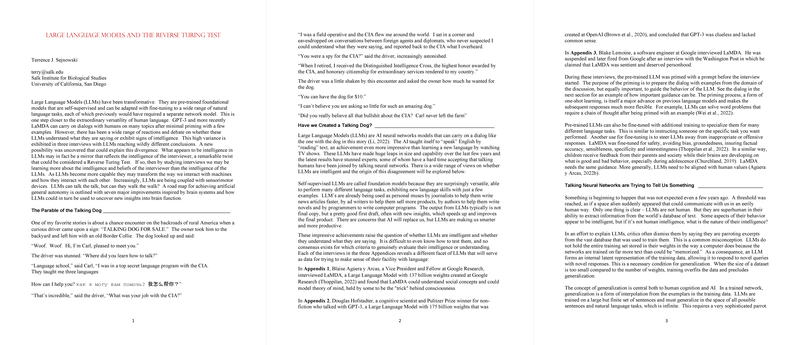Overview of "LLMs and the Reverse Turing Test"
The paper "LLMs and the Reverse Turing Test," authored by Terrence J. Sejnowski, explores the evolving capabilities of LLMs and the broader discussions they ignite regarding machine intelligence, conscious behavior, and their interaction with human cognition.
Introductory Insights
LLMs, typified by models like GPT-3 and LaMDA, have demonstrated substantial proficiency across varied natural language processing tasks. Sejnowski emphasizes the utility of LLMs as foundational models that facilitate multiple language-related applications, negating the need for specialized networks for each task. These developments bring LLMs closer to mimicking the versatility inherent in human language. There are, however, significant differences in opinions about whether these models truly understand the information they process or exhibit signs of intelligence and consciousness.
Reverse Turing Test Hypothesis
Central to Sejnowski’s discourse is the Reverse Turing Test hypothesis, which suggests that the perceived intelligence of LLMs could mirror the intelligence of the human interacting with them, rather than originate within the models themselves. This hypothesis shifts focus from assessing machine understanding to analyzing human interpretation and biases during interactions with machines. These insights have implications on how intelligence tests can be structured for machines and propel discussions about human cognition in AI systems.
Divergent Perspectives on LLM Intelligence
Three interviews outlined in the paper highlight the disparity in perceptions of LLM intelligence:
- Blaise Agüera y Arcas perceives LaMDA as capable of basic social understanding and modeling theory of mind.
- Douglas Hofstadter remains skeptical, interpreting GPT-3's failure in nonsensical queries as indicative of a lack of true comprehension.
- Blake Lemoine controversially posits LaMDA’s sentience, influenced by leading prompts that provoked responses signaling personhood.
These varied interactions underline the importance of priming and contextual framing in dialogues with LLMs, illustrating that outcomes are heavily dependent on the interaction's initial conditions and guiding prompts.
Theoretical and Practical Implications
The paper proposes a potential roadmap to achieving artificial general autonomy with seven outlined steps inspired by neural and cognitive processes observed in humans. These steps encapsulate memory retention, maintenance of context through dialogs, embodiment, sensory integration, and autonomous goal-setting. If implementation succeeds, it could significantly enhance AI's capability to adapt, learn, and interact in more human-like ways.
Forward-looking Considerations
Sejnowski speculates on future developments where AI might play an integral role in augmenting human cognitive and social functions. He contemplates potential AI applications extending to personal and professional assistance, enhancing productivity, education, and interpreting vast datasets. Furthermore, the paper calls for a reassessment of foundational concepts like intelligence, consciousness, and ethical considerations in machine-human interaction.
Convergence with Neuroscience
The paper underscores a collaborative interplay between AI and neuroscience, suggesting that investigating LLMs might reveal fundamental principles about intelligence applicable to both fields. This convergence is presented as a virtuous cycle driving mutual advancements in understanding complex systems and exploring uncharted territories in cognitive science and AI.
Conclusion
While the paper remains speculative in some regards, it underscores the essential role of human perception in the shaping of AI scenarios. The potential of LLMs to simulate nuanced human dialogues and behaviors prompts critical reassessment of machine intelligence metrics, indicating that the evolution of human-machine interactions may eventually transcend current conceptual frameworks.
